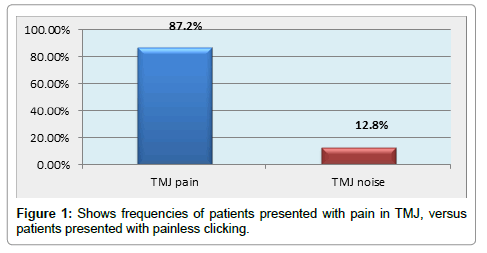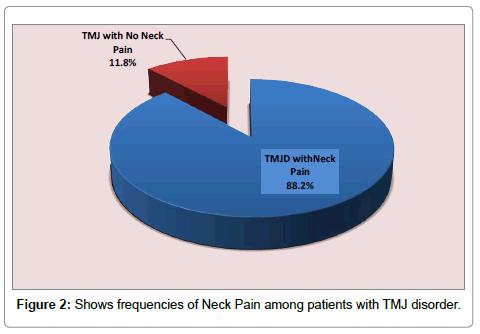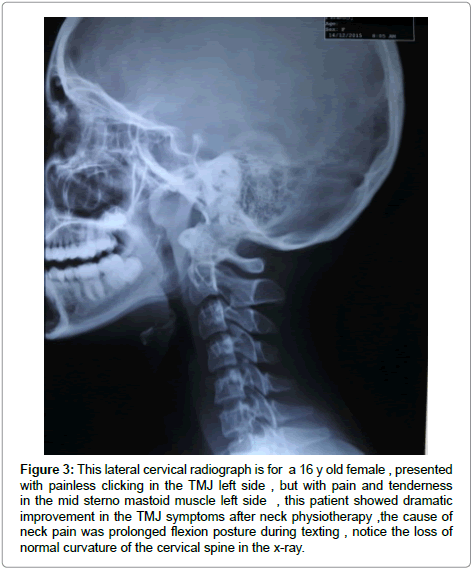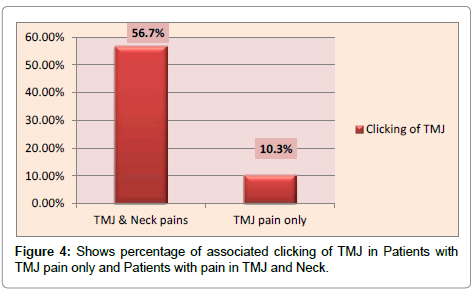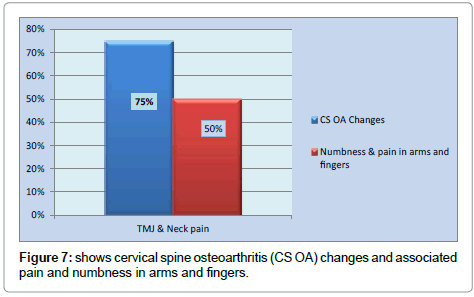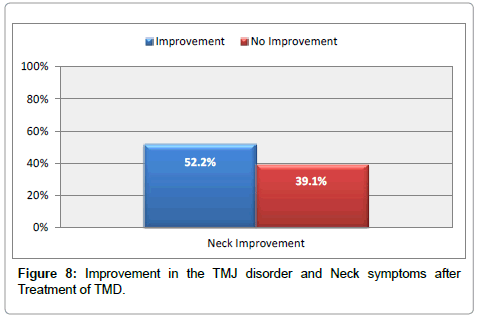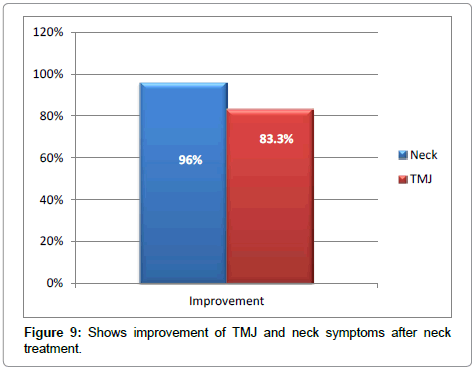Research Article Open Access
Contribution of Cervical Spine in Temporomandibular Joint Disorders: A Cross-Sectional Study
Suha N Aloosi1*, Sarmad M Mohammad2, Taha Ahmed Qaradakhy3 and Seerwan O Hasa41Department of Maxillofacial Surgery, Sulaimani University, Iraq
2Department of Oral Surgery, Shorsh Teaching Center of Dentistry, Iraq
3Department of Rheumatology, Sulaimani Internal Medicine Teaching Hospital, Iraq
4Department of Neurosurgery (student), Sulaimani Teaching Hospital, Iraq
- *Corresponding Author:
- Suha N Aloosi, B.D.S, FICMS
Maxillofacial Surgeon
Teaching Hospital Sulaimani
Kurdistan, Iraq, Lecturer in Sulaimani University FICMS, Iraq
E-mail: suha_aloosi@yahoo.com
Received Date: August 14, 2016; Accepted Date: September 09, 2016; Published Date: September 15, 2016
Citation: Aloosi SN, Mohammad SM, Qaradakhy TA, Hasa SO (2016) Contribution of Cervical Spine in Temporomandibular Joint Disorders: A Cross-Sectional Study. J Interdiscipl Med Dent Sci 4:204. doi:10.4172/2376-032X.1000204
Copyright: © 2016 Aloosi SN, et al. This is an open-access article distributed under the terms of the Creative Commons Attribution License, which permits unrestricted use, distribution, and reproduction in any medium, provided the original author and source are credited.
Visit for more related articles at JBR Journal of Interdisciplinary Medicine and Dental Science
Abstract
Background: Temporomandibular joint (TMJ) pain refers to pain of muscles in the orofacial region. There are significantly higher proportion of signs and symptoms of Temporomandibular disorder (TMD) in those whom had both jaw and neck/shoulder muscles tenderness. The objective of this cross-sectional study was to evaluate the existence and the relationship between Temporomandibular disorders and neck pain and the effect of neck treatment in improving the symptoms and signs of the disorder. Method: 39 patients were included in our study. All were examined and treated for Temporomandibular disorder as first line, then referred to rheumatologist for cervical spine assessment and neck treatment as second line of management. Result and Conclusion: about 88.2% of patients, presented complaining of Temporomandibular disorder symptoms had neck pain concomitantly and a significant improvement in neck pain was noticed when treating the Temporomandibular joint (P=0.001). The Temporomandibular joint symptoms were also significantly improved when neck is treated (P<0.001). Moreover and interestingly, 100% of those who did not report pain in the Temporomandibular joints, but presented only with clicking, had reported pain in the neck at presentation. Clicking in one or both Temporomandibular was reported in 56.7% of patients presented with pain in both neck and the temporomandibular joint .The study concluded that disorders of Temporomandibular Joint and neck are significantly related to each other. Pathology in one can influence the pathology in the other same as treatment of each of them shows improvement of the other as well. Although the result of this study is significant, but to provide evidence-based criteria for the clinician and for more understand cause and effect relationship, a more stratified, randomized control trail is needed to support involving cervical spine by physiotherapy.
Keywords
Temporomandibular disorder; Cervical spine; Temporomandibular join
Abbreviations
TMJ: Temporomandibular Joint, TMD: Temporomandibular Disorder, C: Cervical spine vertebra, OA: Osteoarthritis, CS: Cervical Spine, RDC/TMD (Research Diagnstic Criteria for Temporomandibular Disorder), DC: Diagnostic Criteria
Introduction
Temporomandibular disorders (TMD) are defined by the American Academy of Orofacial Pain as a collective term for a number of clinical problems involving the masticatory musculature, the temporomandibular joints (TMJs), and their associated structures. This dysfunction impairs chewing, swallowing, and speaking, and the main signs are joint noises, reduced range of motion, and mandibular deviation during TMJ function [1]. It is distinguished from mayofacial pain which has been reorganized in the new DC/TMD (Diagnostic Criteria for Temporomandibular Disorders) into myalgia (muscle pain disorders) and myofascial pain with referral [2]. The jaw is an essential part of the human motor system with a close relationship with the headneck motor system [3,4]. The prevalence of masticatory dysfunction may be about 45% in the population although only half of these patients report symptoms [5]. According to the National Institute of Dental and Craniofacial Research the prevalence of TMD is between 5% and 12%. The prevalence rates of TMJ disorders are higher among younger persons. TMJ disorders are at least twice as prevalent in women as men [6]. Patients with musculoskeletal pain and dysfunction are likely to present in association signs and symptoms of cervical involvement [4,7,8]. Researchers have embarked on the impact of disorders in the “upper quarter” on body posture and pain experienced in various areas of the body [9], and many studies have found a relationships between the presence of signs and symptoms in the jaw region and in the neck/ shoulder area [10]. A high proportion of signs and symptoms of TMD was noticed in patients with both jaw muscle tenderness and neck/ shoulder muscle tenderness [11]. Physiological and anatomical data establishes the existence of close links between the masticatory system and the cervical spine [5]. Interdependence between the cervical and the trigeminal sensory-motor systems has been hypothesized as an explanation for this relation [4,12]. The TMJ is a load-bearing joint and bruxism loads the joint excessively. An oral appliance helps to control bruxism. However, not all patients respond favorably, this could be explained by cervical spine involvement. Decreasing the intensity of bruxism by managing cervical spine disorders reduces pain that originates from arthrogenous involvement [13]. Bruxism is more common in patients who have mayo facial pain in the masticatory and cervical spine muscles. Patients who have TMDs report neck symptoms more frequently [14]. It is pointed out by many authors that pain in the upper quarter and masticatory motor system may be caused by cervical spine disorders and vice versa [10]. According to literature, cervical spine as a predisposing, factor to masticatory muscle pain is highlighted in the following theories [13] first is that an afferent input associated with neck pain converges onto trigeminal motor neurons in the trigemino cervical nucleus, results in an increase in masticatory muscle hyperactivity and pain [15]. The second theory suggests that the masticatory muscles contract in response to the contraction of cervical spine muscles. A synergistic relationship between the cervical spine and the muscles of mastication is observed with jaw and neck muscles during normal activities involving chew, talk, and yawn. Reciprocal innervations of opposing muscles have been demonstrated as agonistic and antagonistic [16], an increased muscle tension in the upper quarter leads to compensatory changes in the spinal region so as to correct the posture [17,18]. Occlusion can be an extension of general postural control; it is a part of a complete system of bones, muscles, and joints. Occlusion must be synchronized with healthy mandibular function as it relates to a healthy head position and by extension a healthy posture [19]. The last explanation is that neck pain makes the patients to bruxes this may be exacerbated by patient response to neck pain [13]. Neck pain refractory to appropriate conventional therapy may respond to dental procedures ranging from occlusal restoration, use of a removable intraoral splint or reshaping of one or more teeth [4]. The purpose of this study is to evaluate the relationship between TMD and neck pain, and the influence of neck treatment on TMD. Although neck pain is one of the criteria to diagnose TMD according to the RDC/DMT Research Diagnostic Criteria for Temporomandibular Disorders [20], still there is shortage in evidence in the assessment and in supporting the inclusion of neck treatment in the TMD treatment protocol. Understanding and investigating the cause/ effect relation between cervical spine disease and TMD will influence the treatment plan of TMD and encourage the possibility for physiotherapy of neck in patients with TMD.
Method
A cross- sectional study was conducted on 39 patients who suffered from TMD. The patients were presented to the out patients maxillofacial unit in Sulaimani teaching hospital, Sulaimani city, Kurdistan, Iraq , and dignosed as having TMD according to DC/TMD ( Research diagnostic Criteria for Temporomandibular disorder). Exclusion criteria involved patients with recent history of trauma to head and face, rheumatoid arthritis and those with pain of dental origin when their complain resolved after sole treatment of their teeth., patients with history of systemic inflammatory bone disease like Rheumatoid arthritis were also excluded. After the informed consent was obtained, eligible Patient’s biographic and clinical data were all recorded, history of the symptoms including pain and tenderness clicking were recorded. a thorough intra and extra oral examination including mouth opening, teeth, occlusion, TMJ, all the muscles of mastication, in addition to examination of neck muscles (Sternocleidomastoid, Trapzius, and all neck muscles in the region of the linea nuccae bilaterally). Laboratory and Radiological investigation were recommended for all patients including plain TMJ view, cervical views, CT scan or MRI were recommended accordingly. After the diagnosis, the patients all the participants (39 patients) were treated by conservative management of Temporo mandibular joint pain and neck pain by reassurance of patients and instruction (about diet, sleeping pattern and jaw movement), non-steroidal anti-inflammatory drugs, muscle relaxants like myogesics and amitryptiline tablet at night. Physiotherapy and splint therapy were also applied accordingly. An Informed consent was obtained from each subject before treatment or enrolling in the study. For the patients who had a mixed neck pain with the main complain of presentation of TMJ disorder (25 patients), they were also send to receive treatment for the neck in addition to the basic conservative treatment of TMD, the treatment included medications, physiotherapy for the neck and shoulder muscles The physiotherapy of the neck involved manual therapy, active and passive stretching, strengthening of involved muscles, and postural exercises, instruction regarding cervical spine home care. The data Statistical analysis was performed using SPSS-version 21. Correlation analysis was calculated with Chi-square test. The level of statistical significant was considered at p<0.05.
Results
All of the 39 patients that had been enrolled in the study were of different age groups. The Mean and the standard deviation (SD) of the patient’s age were 36.3 ± 15.62 (ranges 16-70) years old, in which 82.1% of them were female and 17.9% were male. (64.1%) of the patients were housewives, (23.1%) desk jobs, (10.3%) free works and (2.6%) of them were car driver. About 87.2% of the patients reported pain in one or both TMJs, 12.8% complained only from noise in their TMJs (Figure 1). Regarding the incidence of neck pain with the TMJ disorder, 88.2% of our patients who had pain in one or both TMJs had reported pain in the neck. The remaining 11.8% complained only from pain in their TMJs .the relation was statistically significant (P=0.046) (Figure 2). Interestingly, 100% of those who did not report pain in the TMJs, but only painless clicking in their TMJs, had showed pain in the neck at presentation like the patient in Figure 3, In addition, clicking in one or both TMJs was reported in 56.7% of patients with TMJ and Neck pains, 10.3% of patients with only TMJ pain (Figure 4). And in a more detailed evaluation of patients , 79.2% of patients with TMJ and neck pains showed radiological osteo-arthritis "OA "changes in C5-C6 level like the patient in Figure 5 , 33.4% in C6-C7 level, 21% in C3-C4 level, 16.7% in C4-C5 level, and 8.3% in C2-C3 level (Figure 6). Radiologically, 75% of patients with TMJ and Neck pain showed degenerative changes in their cervical spine of which 50% reported associated symptoms of pain and numbness in their arms and fingers (Figure 7). About 58.9% of total patients showed improvement in the joint symptoms and signs after treatment of TMD. In addition, 52.2% of those who had improvement in TMD showed improvement in neck pain as well, but 39.1% of them showed no improvement in neck pain (8.7% of them did not have neck pain in the first place), the improvement was significant P-value of=0.001 (Figure 8). Twenty five "25" patients out of our total 39 patients were decided for them to have treatment of neck after application of TMJ treatment measures, and 96% of them had shown improvement of neck pain . In addition, 83.3% of those had shown improvement in TMJ pain with a significant P-value<0.001 .and only 16.7% showed no improvement of TMJ pain (Figure 9).
Figure 3: This lateral cervical radiograph is for a 16 y old female , presented with painless clicking in the TMJ left side , but with pain and tenderness in the mid sterno mastoid muscle left side , this patient showed dramatic improvement in the TMJ symptoms after neck physiotherapy ,the cause of neck pain was prolonged flexion posture during texting , notice the loss of normal curvature of the cervical spine in the x-ray.
Figure 5: This radiograph belongs to a 23–year old female patient presented with tmj clicking and sever pain bilateral, associated with mid sternomastoid painful point, the patient was diagnosed as having minimal spondylotic changes affecting C4 and C5, patient showed some improvement in the TMJ and neck symptoms after using the splint, dramatic improvement was reported after starting neck treatment.
Discussion
The mean and standard deviation (SD) of the patient’s age in our study group were 36.3 ± 15.62 (ranges 16-70) years old. The same results were concluded by Catanzariti et al in th study which showed that the incidence of TMJ pain is typically in the fourth decade of life " 30s" [5]. Female gender was the majority of our patients as many studies agree. This may be related to physiological difference of female gender such as regular hormonal variation, muscular structure, and different characteristics of the conjunctive tissue. In addition, women are more sensitive to pain [21]. Alanen et al. in their study found a possible relationship between upper spine and Temporo mandibular joint (TMJ) dysfunction in patients exerts cervicobrachial stress in their work [22]. Majority of our study patients were house wives (64.1%), the work of housewife in our community is very stressful including stress on cervical spine that may explain our results. The study had concluded that 88.2% of the patients who were having TMJ pain were also having neck pain. The relation was statistically significant (P=0.046). The same result was concluded in the study of Wiesinger et al, which shows a significant relationship (P-value of<0.0001) between TMJ and neck, pain [4]. The study of Catanzariti et al also highlighted the relationship between TMJ, neck pain and he suggested searching for TMJ pathologies in patients with refractory neck pain, and that TMJ pain with other factors will exacerbate neck pain [5]. A study of Komiyama et al showed that by injection of hypertonic saline in the trapezius muscle result in pain over TMJ region [15]. Interestingly, our study showed that 100% of patients with neck pain had reported TMJ sounds without any pain in TMJ. Wiesinger et al. reported that frequent TMJ sounds were associated significantly with back pain (P<0.0001) [4]. The radiological assessment of cervical spine of our patients revealed that 75% of those with TMJ and neck pains showed osteoarthritis (OA) changes in different levels of their cervical spines. 50% of them reported associated symptoms of pain and numbness in their arms and fingers. This is due to that 79.2% of OA changes were within C5-C6 level, 33.4% in C6-C7 level. While the higher levels of cervical spines showed less involvement with OA changes: 8.3% in C2-C3 level, 21% in C3-C4 level, and 16.7% in C4- C5 level. Therefore, it cannot be concluded whether that the TMJ pain that associated with neck pain is more likely due to neck and shoulder muscle pathology or due to cervical bony lesions or not . All of our study patients, who presented with TMD, were conventionally treated by instructing them, prescribing medication, teaching them exercises for their TMJs, and construction of occlusal splint if needed. 58.9% of them showed improvement in their TMD symptoms, in addition,52.2% of them showed improvement of neck pain as well, however, (39.1%) showed no or mild improvement of neck pain. A significant relationship between TMD treatment and neck pain improvement was found (P-value=0.001). In addition, a significant improvement of TMJ pain after treating neck was reported (P-value<0.001). 64.1% of our patients were scheduled for neck physiotherapy by which 96% of them had showed improvement of neck pain and 83.3% of them also showed improvement in their TMJs’ condition as well. On contrary, the study of George et al shows that manual therapy applied to upper cervical spine dose not significantly improve TMJ symptoms [23]. Our result agrees with conclusions of other studies, which pointed out that elimination of cervical spine pain was reported by the subjects after treatment of TMJ. In Karolina et al study, the results of tests performed 3 months after the beginning of occlusal splint therapy provides a significant improvement in TMJ function (p<0.05), and a reduction of spinal pain [24] in a study of Calixtre et al. concluded that pain in patients with TMD was significantly reduced after neck therapy, and the limitation in the jaw movement was also significantly improved [1]. This highlights the need for a more stratified study, to evaluate the influence of neck treatment in TMD symptoms improvement and whether the neck pain is pre disposing the joint for TMD, or that Neck pain can perpetuate TMD.
Conclusion
There is a significant relationship between TMJ and neck pathologies. Treatment of neck pain should be considered in patients with TMJ symptoms and vice versa. Although the result of this study is significant, but to provide evidence-based criteria for the clinician and for more understand cause and effect relationship, a more stratified, randomized control trail is needed. Approaching the cervical spine by physiotherapy in TMJ disease treatment protocol as complimentary treatment need to be supported.
Acknowledgement
We wish to thank the and all the medical personnel in Sulaimani Teaching Hospital, Kurdistan / Iraq , participated in facilitating management of the patients specially Diagnosis Radiology department and physiotherapy department , and we wish to thank Dr Fattah Hawrami for his effort completing the statistical part of the study .
References
- Calixtre LB, da Silva Grüninger BL, Haik MN, Alburquerque-Sendín F, Oliveira AB (2016) Effects of cervical mobilization and exercise on pain, movement and function in subjects with temporomandibular disorders: a single group pre-post test. J Appl Oral Sci 24
- Schiffman E, Ohrbach R, Truelove E, Look J, Anderson G et al. (2014) Diagnostic Criteria for Temporomandibular Disorders (DC/TMD) for Clinical and Research Applications: Recommendations of the International RDC/TMD Consortium Network and Orofacial Pain Special Interest Group . J Orofac Pain 28: 6–27.
- Eriksson PO, Häggman-Henrikson B, Nordh E, Zafar H (2000) Co-ordinated mandibular and head-neck movements during rhythmic jaw activities in man. Journal of dental research 79: 1378-1384.
- Wiesinger B, Malker H, Englund E, Wanman A (2007) Back pain in relation to musculoskeletal disorders in the jaw-face: A matched case–control study. Pain 131: 311–319.
- Catanzariti JF, Debuse T, Duquesnoy B (2005) Chronic neck pain and masticatory dysfunction. Joint Bone Spine 72: 515–519.
- National Institute of Dental and Craniofacial Research (2014) Prevalence of TMJD and Its Signs and Symptoms.
- Armijo-Olivo S, Magee D (2012) Cervical Musculoskeletal Impairments and Temporomandibular Disorders. J Oral Maxillofac Res 3: 4.
- De Laat A, Meuleman H, Stevens A,Verbeke G (1998) Correlation between cervical spine and temporomandibular disorders. Clinical oral investigations 2: 54-57.
- Okamoto K, Tashiro A, Chang Z, Thompson R, Bereiter DA (2012) “Temporomandibular joint-evoked responses by spinomedullary neurons and masseter muscle are enhanced after repeated psychophysical stress. Eur J Neurosci 36: 2025–2034.
- Wiesinger B, Malker H, Englund E, anman AW (2009) "Does a dose-response relation exist between spinal pain and temporomandibular disorders?. BMC Musculoskeletal Disorders10:
- Inoue E, Maekawa K, Minakuchi H, Nagamatsu-Sakaguchi C, Ono T, et al. (2010) The relationship between temporomandibular joint pathosis and muscle tenderness in the orofacial and neck/shoulder region. Oral Surg Oral Med Oral Pathol Oral Radiol Endod 109: 86-90.
- Browne PA, Clark GT, Kuboki T, Adachi NY (1998) Concurrent cervical and craniofacial pain: a review of empiric and basic science evidence. Oral Surg Oral Med Oral Pathol Oral Radiol Endod 86: 633-640.
- Kraus S (2007) Temporomandibular Disorders, Head and Orofacial Pain: Cervical Spine Considerations. Dent Clin North Am 51: 161-193.
- Wieckiewicz M, Paradowska-Stolarz A, Wieckiewicz W (2014) Psychosocial Aspects of Bruxism: The Most Paramount Factor Influencing Teeth Grinding. Bio Med Research International.
- Komiyama O, Arai M, Kawara M, Kobayashi K, De Laat A (2005) Pain patterns and mandibular dysfunction following experimental trapezius muscle pain. J Orofac Pain 19(2): 119-126.
- Smith AM (1981) The coactiviation of antagonist muscles. Can J Physiol Pharmacol 59: 733-747.
- Miernik M, Wieckiewicz M, Paradowska A, Wieckiewicz W (2012) Massage therapy in myofascial TMD pain management. Adv Clin Exp Med 21: 681-685.
- Germain L (2012) “Differential diagnosis of toothache pain: part 2, nonodontogenic etiologies,”.Dentistry Today vol. 31: 88-89.
- Nassery H (2015) TMJ/TMJ The Connection Between Teeth, Neck, Spine & Skull. MedHelp International
- Dworkin SF, LeResche L (1992) Research diagnostic criteria for temporomandibular disorders: Review criteria, examinations and specifications, critique. J Craniomandib Disord 6: 301-355.
- Monteiro DR, Zuim PR, Pesqueira AA, Ribeiro Pdo P, Garcia AR (2011) Relationship between anxiety and chronic orofacial pain of temporomandibular disorder in a group of university students. J Prosthodont Res 55: 154-158.
- Alanen PJ, Kirveskari PK (1984) Occupational cervicobrachial disorder and temporomandibular joint dysfunction. Cranio: the Journal of craniomandibular practice 3: 69.
- George JW, Fennema J, Maddox A, Nessler M, Skaggs CD (2007) The effect of cervical spine manual therapy on normal mouth opening in asymptomatic subject. J Chiropr Med 6: 141-145.
- Walczynska-Dragon K, Baron S, Nitecka-Buchta A, Tkacz E (2014) Correlation between TMD and Cervical Spine Pain and Mobility: Is the Whole Body Balance TMJ Related?. BioMed Research International.
Relevant Topics
- Cementogenesis
- Coronal Fractures
- Dental Debonding
- Dental Fear
- Dental Implant
- Dental Malocclusion
- Dental Pulp Capping
- Dental Radiography
- Dental Science
- Dental Surgery
- Dental Trauma
- Dentistry
- Emergency Dental Care
- Forensic Dentistry
- Laser Dentistry
- Leukoplakia
- Occlusion
- Oral Cancer
- Oral Precancer
- Osseointegration
- Pulpotomy
- Tooth Replantation
Recommended Journals
Article Tools
Article Usage
- Total views: 27563
- [From(publication date):
October-2016 - Apr 01, 2025] - Breakdown by view type
- HTML page views : 26184
- PDF downloads : 1379

